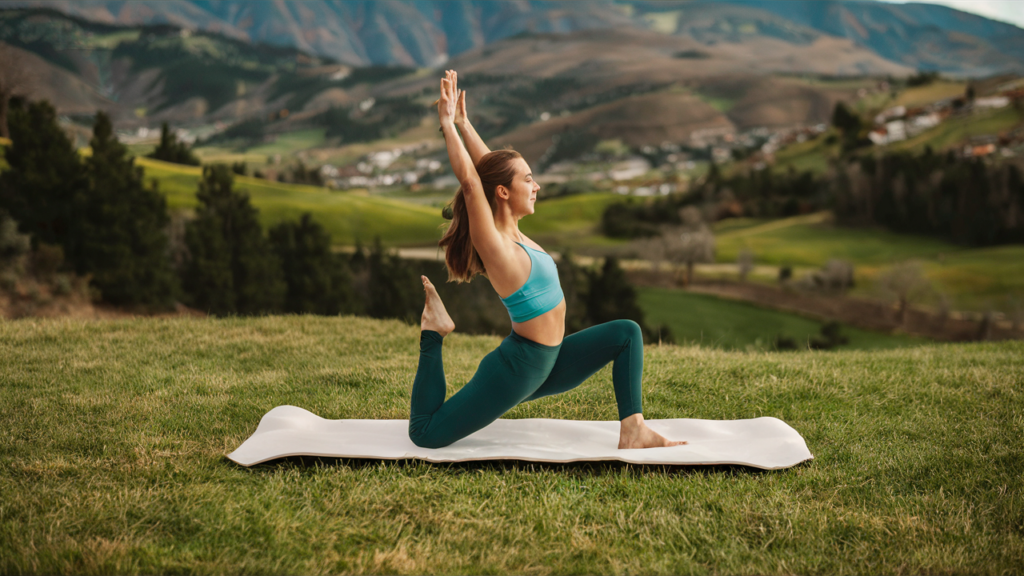Exercise mats and yoga mats are not the same; they serve different purposes and have unique features. While yoga mats are specifically designed for practicing yoga and meditation, exercise mats are more versatile and suitable for a variety of workouts and exercises.
Yoga mats are typically thinner and provide better grip for yoga poses, while exercise mats offer more cushioning and support for high-impact activities like cardio or strength training. Understanding the differences between these mats can help you choose the right one for your fitness routine, ensuring comfort and safety during your workouts.
Let’s explore the distinctions between exercise mats and yoga mats in more detail.
Introduction To Exercise And Yoga Mats
Exercise mats and yoga mats are often confused with each other, but they serve different purposes in fitness routines. While yoga mats are designed to provide cushioning and stability during yoga poses and meditation, exercise mats are primarily used for high-impact exercises like jumping jacks or push-ups.
Yoga mats are thinner and more lightweight, making them easier to carry to and from yoga classes. They also offer better grip and traction, which is essential for maintaining balance during yoga poses. Exercise mats, on the other hand, are thicker and more durable, providing better shock absorption for exercises that involve jumping or running.
It’s a common misconception that exercise mats and yoga mats are interchangeable, but using the wrong type of mat can lead to discomfort or even injury during your workout. It’s important to choose the right mat for your specific exercise routine to ensure that you’re getting the support and stability you need to perform at your best.
Material Differences
Exercise mats and yoga mats may seem similar, but they have notable differences. The material used in their construction sets them apart. Exercise mats often feature a variety of foam, offering different textures and densities. In contrast, yoga mats are typically thinner and made with a specific thickness and density to provide a stable and supportive surface for yoga practice.
Design And Functionality
Exercise mats and yoga mats may seem similar, but they have distinct differences in design and functionality. When it comes to grip and slip resistance, yoga mats are specifically designed to provide a firm grip, allowing practitioners to maintain stability during poses. They often have a textured surface that enhances traction, preventing slips and falls.
On the other hand, exercise mats are more versatile in terms of their size and shape considerations. They come in various sizes, including larger options for activities that require more space, such as pilates or aerobic workouts. Exercise mats also offer cushioning and support, making them suitable for a wide range of exercises beyond yoga.
In conclusion, while both mats serve the purpose of providing a comfortable surface for physical activities, yoga mats excel in grip and slip resistance, while exercise mats offer more versatility in terms of size and shape. Whether you’re practicing yoga or engaging in other exercises, choosing the right mat that suits your specific needs is essential for a safe and enjoyable workout experience.
Durability And Longevity
Exercise mats and yoga mats are often used interchangeably, but there are some differences in terms of durability and longevity. When it comes to wear and tear factors, exercise mats are designed to withstand high-impact activities such as cardio exercises, weightlifting, and HIIT workouts. They are generally thicker and made from materials like rubber or PVC, providing enhanced shock absorption and durability.
On the other hand, yoga mats are primarily designed for yoga and other low-impact exercises. They are thinner and made from materials like TPE or natural rubber, offering excellent grip and stability during yoga poses. While yoga mats may not be as durable as exercise mats, they can still last for a long time with proper care and maintenance.
To ensure the longevity of both mats, it is important to clean them regularly and store them in a cool and dry place. Avoid exposing them to direct sunlight or harsh chemicals that could cause damage. By taking good care of your mats, you can extend their lifespan and make the most out of your workouts or yoga sessions.
Comfort And Support
Exercise mats and yoga mats are similar in providing comfort and support during workouts. Both types of mats offer adequate cushioning for joints, reducing the impact on knees, elbows, and other body parts. This cushioning is especially beneficial for individuals with joint pain or discomfort. Moreover, the right mat can significantly enhance performance during exercises, providing a stable and comfortable surface for various movements and poses. Whether practicing yoga, Pilates, or other floor exercises, a suitable mat is crucial for a safe and effective workout.
Environmental Impact
Exercise mats and yoga mats may seem similar, but they have different environmental impacts. Yoga mats are usually made from eco-friendly materials like natural rubber, while exercise mats can be made from PVC, which has a higher environmental impact due to its manufacturing process and non-biodegradable nature.
| Environmental Impact | |
| Eco-friendly Options | Recyclability and Sustainability |
| Exercise mats and yoga mats differ in their environmental impact. | |
| Opt for eco-friendly options to reduce harm to the planet. | |
| Look for mats made from recyclable materials for sustainability. |
Price Point And Affordability
Exercise mats and yoga mats are not the same in terms of price point and affordability. While exercise mats are generally more affordable, yoga mats can vary in price depending on the brand and quality. It’s important to consider your budget and specific needs when choosing between the two.
| Price Point and Affordability |
|---|
| Budget Considerations: Exercise mats and yoga mats vary in price based on material and brand. |
| Investment vs. Expense: Consider your long-term fitness goals when deciding on a mat. |
Making The Right Choice
|
Exercise mats and yoga mats serve different purposes. Exercise mats offer more cushioning for high-impact activities like aerobics and HIIT. Yoga mats, on the other hand, provide better grip for yoga poses and meditation. Identify your workout needs before choosing a mat. For yoga, opt for a non-slip, thinner yoga mat. For pilates or core exercises, choose a thicker exercise mat for comfort. Consider the material of the mat for durability. Rubber mats are eco-friendly and offer good grip, while PVC mats are durable and budget-friendly. Ultimately, the right choice depends on your specific workout routines. |
Debunking Myths
Exercise mats and yoga mats are not the same. While exercise mats are designed for general workouts, yoga mats are specifically made for yoga practice, with better grip and cushioning to support different poses and movements. Don’t be fooled by the misconception that they serve the same purpose.
| Exercise Mats | Yoga Mats |
| Designed for general fitness routines | Specifically for yoga practice |
| Provide cushioning and support | Thinner for better stability |
| Can be used for various exercises | Primarily for yoga poses |
| Offer versatility in workouts | Focus on grip and traction |

Frequently Asked Questions
Are Exercise Mats And Yoga Mats The Same?
No, exercise mats and yoga mats are not the same. Although they may look similar, exercise mats are designed for high-impact activities like aerobics, while yoga mats provide cushioning and stability for yoga poses.
What Is The Main Difference Between Exercise Mats And Yoga Mats?
The main difference between exercise mats and yoga mats is their thickness. Exercise mats are thicker and provide more cushioning for high-impact activities, while yoga mats are thinner and provide better stability for yoga poses.
Can I Use A Yoga Mat For Exercise?
Yes, you can use a yoga mat for exercise, but it may not provide enough cushioning for high-impact activities. If you plan to do exercises like jumping jacks or burpees, it’s best to use an exercise mat that provides more shock absorption.
What Are The Benefits Of Using An Exercise Mat?
Using an exercise mat provides several benefits, including better shock absorption, improved traction, and increased comfort during high-impact activities. It also protects your joints from hard surfaces and helps prevent injuries.
Conclusion
Exercise mats and yoga mats have similarities but serve different purposes. While yoga mats are designed for stability and grip during yoga practice, exercise mats offer more cushioning and support for various workouts. Understanding the differences can help you choose the right mat for your specific fitness needs.
So, make an informed decision to enhance your workout experience.








